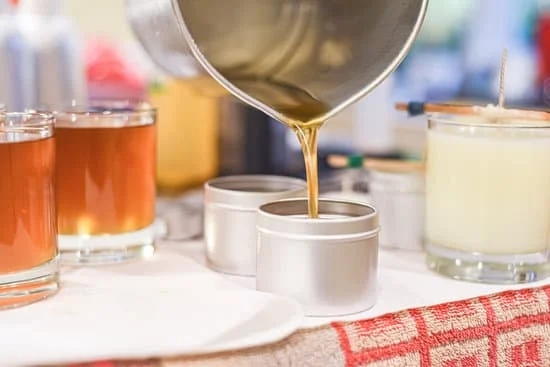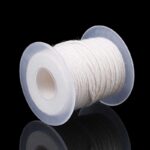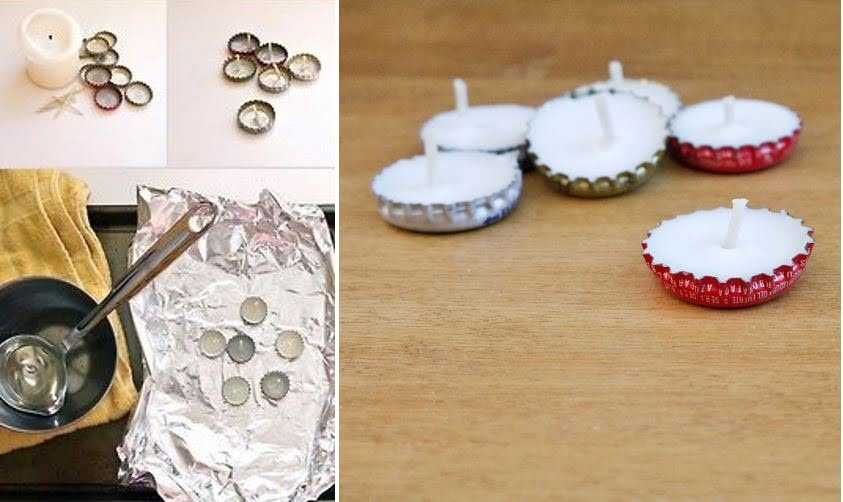When making candles, why does the top crack? Understanding the science behind candle making is crucial in addressing this common issue. The art of creating candles involves a delicate balance of various factors such as heat distribution, quality of wax, cooling techniques, and the use of fragrance oils and additives. In this article, we will delve into the reasons why candle tops crack and explore how to prevent this from happening.
One of the common causes of cracking in candles is uneven heat distribution during the cooling process. When the candle cools too quickly or too slowly, stress can build up in the wax, leading to cracks on the surface. This emphasizes the importance of proper cooling techniques to ensure a smooth finish.
Additionally, the type and quality of wax used play a significant role in preventing cracking. Choosing a high-quality wax that is suitable for your desired candle style can help minimize cracking issues.
In addition to heat distribution and wax quality, factors such as fragrance oils and additives can also impact the likelihood of cracking in candles. Certain scents or additives may affect the composition of the wax, making it more prone to cracking. By understanding these contributing factors and implementing troubleshooting tips to prevent cracking, you can elevate your candle-making skills and create flawless products.
Common Causes of Cracking
When making candles, one common issue that many candle makers face is cracking on the top of their finished product. This can be frustrating, especially after putting in the time and effort to create a beautiful candle. One of the main reasons why the top of a candle may crack is due to heat distribution issues during the cooling process.
Uneven Cooling
One of the most common causes of cracking in candles is uneven cooling. When candles cool too quickly or too slowly, it can cause stress on the surface of the wax, leading to cracks forming on the top. To prevent this from happening, it’s important to allow your candles to cool at a consistent rate. Avoid placing them in drafts or near air conditioning vents, as this can cause uneven cooling.
Using Improper Containers
Another factor that can contribute to cracking in candles is using improper containers for pouring your wax. Glass containers, for example, may not be able to withstand the temperature changes during cooling, leading to cracks forming on the surface. It’s important to choose containers that are specifically designed for candle making and can handle the heat without cracking.
Overheating
Furthermore, overheating your wax can also result in cracking issues when making candles. If your wax becomes too hot before pouring into containers, it can cause excessive shrinkage during cooling, which may lead to cracks forming on the surface. To avoid this, always melt your wax at the recommended temperature and keep an eye on it throughout the process.
Quality of Wax Matters
When making candles, choosing the right type of wax is crucial to prevent cracking on the top of the candle. The quality and type of wax used can greatly impact the overall look and durability of your candles. Here are some key points to consider when selecting your wax:
- Choose a high-quality wax: Opt for waxes specifically designed for candle making, such as soy wax, paraffin wax, or beeswax. These waxes are known for their smooth texture and ability to hold fragrance oils well.
- Avoid using low-quality or old wax: Low-quality or old wax can cause problems with adhesion and uniform cooling, leading to cracks on the surface of your candles. Make sure to invest in fresh, premium-grade wax for best results.
- Consider the melting point: Different waxes have different melting points, which can affect how evenly the candle burns and how resistant it is to cracking. Be sure to choose a wax with a melting point suitable for your specific candle-making needs.
Additionally, additives such as stearic acid or vybar can be used to modify the texture and hardness of the wax, further influencing its ability to resist cracking. By carefully considering the quality and type of wax you use in your candle making process, you can help prevent issues like cracking and ensure that your candles turn out beautifully every time.
Ultimately, when making candles why does the top crack is often caused by using an inappropriate or poor-quality wax that is not suitable for candle making. By choosing a high-quality wax that melts evenly and adheres well to fragrance oils and additives, you can minimize the risk of cracking and create candles that are visually appealing and long-lasting. Remember that attention to detail and precision in selecting materials are key factors in successful candle making.
The Importance of Proper Cooling Techniques
Proper cooling techniques are essential in candle making to prevent cracks from forming on the surface of your candles. When the wax cools too quickly or unevenly, it can lead to unsightly cracks that detract from the overall appearance of your finished product. To ensure a smooth and crack-free finish, here are some tips for mastering the art of proper cooling techniques:
- Allow your candles to cool at room temperature: Letting your candles cool naturally at room temperature helps to ensure even cooling throughout the entire candle, reducing the likelihood of cracking.
- Avoid placing candles in a drafty area: Drafts can cause uneven cooling and may result in cracks forming on the surface of your candles. Choose a still, sheltered area for cooling.
- Consider using a cooling rack: Placing your candles on a cooling rack allows air to circulate around them, promoting even cooling and helping to prevent cracks from forming.
Quality control is key when it comes to achieving perfectly smooth candles without any cracks on top. By implementing proper cooling techniques into your candle making process, you can ensure that your finished products are not only visually appealing but also long-lasting. Remember that patience is essential when it comes to candle making – rushing the cooling process can lead to undesirable results like cracking.
In addition to proper cooling techniques, it’s important to consider the type of wax you are using and how it may impact cracking on the surface of your candles. Choosing high-quality waxes that have been specifically formulated for candle making can help minimize the risk of cracks forming during the cooling process.
By investing in quality materials and taking care with every step of the candle making process, you can create beautiful candles that are free from imperfections like cracks on top.
How Fragrance Oils and Additives Affect Cracking
When it comes to candle making, the addition of fragrance oils and other additives can have a significant impact on the final product. One of the common issues that candle makers may face is cracking on the top surface of their candles. Understanding how fragrance oils and additives affect cracking is essential in creating high-quality, crack-free candles.
Chemical Reactions With Fragrance Oils
Fragrance oils contain various chemicals that can react differently with the wax base during the cooling process. Some fragrance oils may accelerate the cooling process, causing uneven shrinkage and leading to cracks on the surface of the candle. It’s important to carefully select fragrance oils that are compatible with the type of wax being used to minimize cracking issues.
Impact of Additives
Additives such as colorants, UV inhibitors, and stabilizers can also affect the structural integrity of a candle. Certain additives may change the physical properties of the wax, making it more prone to cracking during cooling. It’s crucial to experiment with different combinations of additives and observe how they interact with the wax to determine which combinations produce the best results in terms of reducing cracking.
Proper Mixing and Incorporation
When adding fragrance oils and additives to your candle mixture, ensure that they are thoroughly mixed and fully incorporated into the wax. Incomplete mixing can result in pockets of concentrated fragrance or additives within the candle, leading to uneven cooling and potential cracking issues. By taking care to properly blend all components together, you can minimize the risk of cracking in your finished candles.
Troubleshooting
When making candles, one common issue that candle makers may encounter is cracking on the top surface of the candle. This cracking can be frustrating, especially after putting in time and effort to create a beautiful candle. There are several reasons why this may happen, and understanding these factors can help prevent cracking in your future candle-making projects.
One of the main reasons why the top of a candle may crack is due to rapid temperature changes during the cooling process. When candles cool too quickly or unevenly, stress can build up within the wax, leading to cracks on the surface. To avoid this issue, it is important to allow your candles to cool slowly and evenly at room temperature. Avoid placing them in cold environments or near drafts that can cause rapid cooling.
Another factor that can contribute to cracking in candles is the type and quality of wax used. Different waxes have different melting points and characteristics that can affect how they solidify. Choosing a high-quality wax that is specifically designed for container candles can help reduce the chances of cracking. Additionally, adding additives such as stearic acid or vybar can improve the adhesion properties of the wax and minimize issues with cracking.
Proper pouring techniques and temperatures also play a crucial role in preventing cracks in candles. Pouring wax at too high or too low temperatures can result in stress fractures on the surface as it cools.
It is essential to follow recommended pouring temperatures provided by your wax supplier and ensure that the wax is poured gently to avoid introducing additional air bubbles that could weaken the structure of the candle. By paying attention to these key factors and following best practices, you can minimize cracking issues and create flawless candles for yourself or your customers.
| Cause of Cracking | Preventive Measure |
|---|---|
| Rapid temperature changes during cooling | Allow candles to cool slowly at room temperature |
| Quality of wax used | Select high-quality wax designed for container candles |
| Pouring techniques and temperatures | Follow recommended pouring temperatures and pour gently |
The Role of Pouring Temperature in Crack Formation
When making candles, why does the top crack? One important factor to consider is the pouring temperature of the wax. The temperature at which you pour the melted wax into your candle mold plays a crucial role in whether or not cracking will occur on the surface of your candle. If the wax is poured at too high or too low of a temperature, it can lead to uneven cooling and potential cracks in the finished product.
Ideally, the pouring temperature should be within a specific range depending on the type of wax being used. Different waxes have different optimal pouring temperatures, so it is essential to follow guidelines provided by manufacturers or experienced candle makers. Pouring wax that is too hot can cause shrinkage as it cools, leading to cracks. On the other hand, if the wax is poured too cold, it may not bind together properly, also resulting in cracking.
To avoid cracking due to pouring temperature issues, it is recommended to use a thermometer to monitor and control the temperature of your melted wax. By ensuring that you pour at the correct temperature for the specific type of wax you are using, you can reduce the likelihood of cracks forming on the surface of your candles.
| Key Point | Recommendation |
|---|---|
| Use a thermometer to monitor wax temperature | Ensure proper pouring temperature within recommended range |
| Follow guidelines for specific wax types | Different waxes require different pouring temperatures |
| Avoid extreme temperatures when pouring | Too hot or too cold can result in cracking |
Final Thoughts
When making candles, it is crucial to pay attention to every detail in order to achieve a perfect finished product. One common issue that candle makers often face is cracking on the top of their candles. This can be frustrating after putting in so much time and effort into the crafting process. Understanding why the top of a candle cracks can help in preventing this issue in the future.
One of the main reasons for cracking on the top of a candle is improper heat distribution during the cooling process. If a candle cools too quickly or unevenly, stress can build up within the wax causing it to crack. Ensuring that your candles cool slowly and evenly can help prevent cracking from occurring.
Another factor that can contribute to cracking is the quality of wax used in candle making. Choosing the right type of wax for your specific candles can make a big difference in preventing cracking issues. Additionally, paying attention to pouring temperature and proper cooling techniques are essential steps in ensuring that your candles turn out smooth and crack-free. By taking these factors into consideration, you can increase your chances of creating beautiful, high-quality candles every time.
Frequently Asked Questions
Why Is the Top of My Candle Cracking?
The top of a candle cracks for several reasons, such as temperature changes during cooling or pouring, using the wrong type of wax, or pouring the wax too quickly. These cracks are usually aesthetic issues rather than affecting the candle’s performance.
How Do You Fix a Crack in a Candle?
To fix a crack in a candle, you can gently heat the surface of the candle with a heat gun or hairdryer until it becomes slightly soft and then use your fingers to smooth out the crack. Alternatively, you can remelt and pour a thin layer of wax over the cracked area to fill it in.
What Happens if You Overheat Soy Wax?
Overheating soy wax can result in several negative outcomes, such as discoloration, affecting the fragrance throw, or even causing safety hazards like fires or explosions. It’s essential to follow recommended heating guidelines when working with soy wax to prevent these issues.

Welcome to my candle making blog! In this blog, I will be sharing my tips and tricks for making candles. I will also be sharing some of my favorite recipes.





